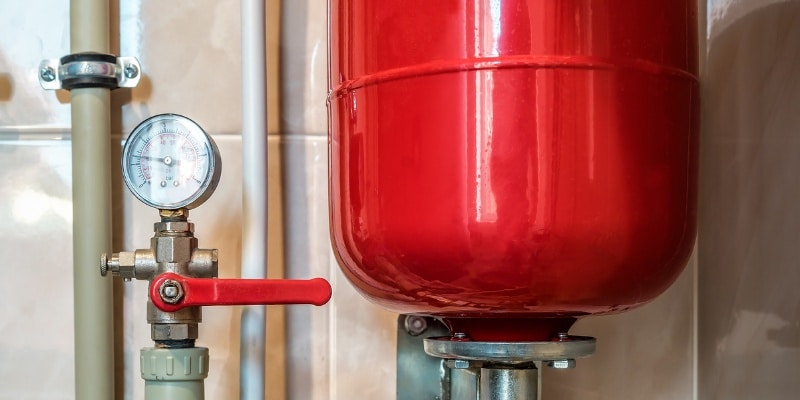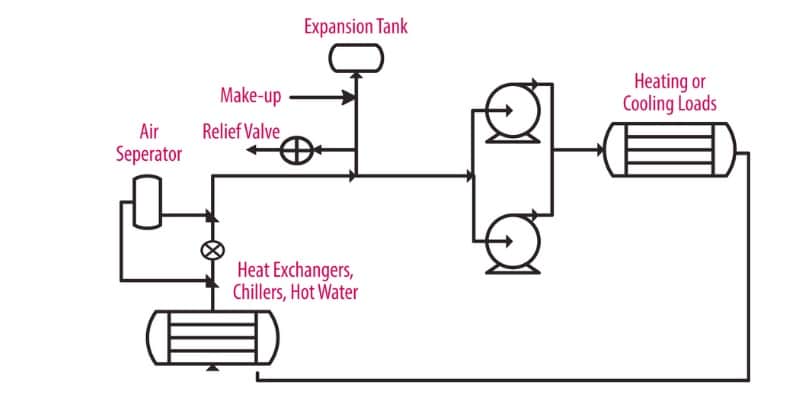Hot showers and baths are simple pleasures, bringing warmth and relaxation after a tiring day. Behind this luxury, our faithful water heaters tirelessly work, ensuring we receive that comforting warmth whenever needed. However, there’s one component of the water heating system that most homeowners tend to overlook: the water heater expansion tank.
So, let’s demystify this underrated component and answer a burning question – is an expansion tank essential for your home? Let’s dive in!
What is a Water Heater Expansion Tank?
A water heater expansion tank, often called an expansion tank, is a small auxiliary tank designed to protect closed (not open to atmospheric pressure) water heating systems and domestic hot water systems from excessive pressure. It is typically installed on the cold-water supply line near or directly above the water heater.

Inside the expansion tank is a rubber diaphragm that divides the tank into two sections:
- Air Side: This side contains pressurized air and is sealed off from the waterside.
- Water Side: This side connects to the cold-water supply line and is where expanded water enters from the water heater.
Wondering how it works?
The expansion tank contains a diaphragm or bladder, dividing it into two sections. One side is filled with air, and the other connects to your water line. When water expands, and pressure rises, the diaphragm flexes, allowing water to enter the tank, which helps maintain a balanced pressure system.
When substances are heated, they usually expand. Our elementary school science taught us this fundamental principle. Water, of course, is no exception.
As your water heater warms up cold water, this water expands. It might seem like a minor detail, but this expansion can significantly impact the internal pressure of your entire plumbing system.
Imagine blowing air into a balloon. As you blow more air, the pressure inside the balloon increases, and if you push it too far, the balloon might pop.
This is how the increased pressure from water expansion can jeopardize the integrity of your plumbing system.
So, what’s the solution to this mounting pressure? That’s where the expansion tank comes into play. Think of it as a backup or pressure relief valve for your water heater.
An expansion tank is a small auxiliary tank attached to your water line. Its main purpose? Handle the extra volume of water produced when the main tank heats the water. But how does such a simple tank manage this?
A diaphragm or bladder divides the space into two parts inside the expansion tank. One side contains air under pressure, while the other connects to the water line.
When the water heater operates, and the water expands, the rising pressure pushes against this diaphragm, allowing excess water to enter the expansion tank. Doing so ensures that the pressure in the main tank remains balanced and safe.
Identifying the Need for an Expansion Tank
The natural question that follows is: does every home with a water heater need an expansion tank? The short answer is no, but many do.
Here’s how to ascertain whether your home might need one:
- Signs of Over-Pressure: One clear sign that your system is under too much pressure is frequent dripping from the relief valve of your water heater. If you notice this, it’s a cry for help from your plumbing system. Another telltale sign is the sound of strain or groaning noises from the pipes – it’s as if they’re telling you they’re feeling the pressure!
- Your Water Supply System: The design of your water supply system plays a significant role. Homes with a closed water supply system—where backflow to the main water supply is blocked—will require an expansion tank. This is because, in such systems, the expanded water has nowhere to go. Conversely, homes with an open system have a natural outlet for excess water. Still, an expansion tank can be a beneficial addition even in these systems.
Several signs can indicate excessive pressure in your plumbing system, including frequent dripping from the relief valve on your water heater or noticeable strain noises. Additionally, the type of water supply system you have can determine the need for an expansion tank.
In a closed water supply system, where backflow is prevented into the main water supply, water has nowhere to go when it expands. This is when an expansion tank becomes essential. In contrast, open systems might not necessarily need one, but having an expansion tank is still beneficial.
Expansion Tank For Water Heater Required By Code
A closed water system has a mechanism, such as a check valve, backflow prevention valve, or pressure-reducing valve, in place that prevents the backward flow of water. This means that as water expands when heated (thermal expansion), it cannot flow back into the main water supply. This can result in increased pressure within the home’s plumbing system.

Why the code requirement:
- Safety Concerns: As the water heats and expands in a closed system, if there’s nowhere for the excess volume and pressure to go, it can lead to an over-pressurized condition. This poses risks such as a burst water line, damaged fixtures, or even a water heater explosion.
- Equipment Longevity: Constant pressure fluctuations and increases can reduce the lifespan of the water heater and other plumbing components.
- Preventing Malfunction: Excessive pressure can cause the water heater’s temperature & pressure relief valve (T&P valve) to discharge frequently, leading to malfunction.
When an expansion tank is installed, it provides a space for the excess volume of water to go when it expands. This effectively manages and reduces the potential for dangerous pressure build-up in the system.
Inside the expansion tank is a diaphragm separating air-filled and water-filled sides. As pressure increases due to thermal expansion, water enters the expansion tank, compressing the air on the other side of the diaphragm, thereby absorbing the pressure.
Many local building codes across various regions and countries mandate the installation of an expansion tank in homes with a closed water system. These codes are developed with safety in mind, ensuring that residential plumbing systems operate without harming homeowners.
If you’re a homeowner or are involved in the construction or renovation of a home, and the property has a closed water system, it’s crucial to be aware of local building code requirements regarding expansion tanks. They enhance the safety of the water heater setup and prolong the life of plumbing components by mitigating the risks associated with thermal expansion.
Always consult with local plumbing professionals or inspectors to ensure compliance with the latest codes and regulations.
Advantages of Installing a Water Heater Expansion Tank
Apart from preventing the potential mess of leaks and water damage, expansion tanks play a role in ensuring the longevity of your water heater. By reducing pressure-induced wear and tear, the lifespan of your heater can be significantly extended, making it an investment-saving decision in the long run.
Beyond the safety aspect, there are several compelling reasons to consider installing a water heater expansion tank:
- Protection from Water Damage: Water damage from leaks can be both a nuisance and expensive to repair. Expansion tanks safeguard against this, capturing excess water before it becomes problematic.
- Prolonging Heater Life: Every appliance has a shelf life. However, by reducing the strain and pressure on your water heater, you’re effectively increasing its lifespan, ensuring you get the most bang for your buck.
- Peace of Mind: Knowing you have additional protection against potential plumbing disasters can be comforting. It’s one less thing to worry about in the complex world of homeownership.
Cost to Install or Replace an Expansion Tank
Several factors will determine the final price for homeowners considering installing or replacing a water heater expansion tank.
Cost of the Expansion Tank Itself:
- Type and Size: The tank’s cost will depend on its capacity and type. Larger tanks designed for bigger homes or commercial properties naturally cost more than those intended for smaller homes.
- Brand and Quality: Trusted brands or tanks with extended warranties might have a higher price point, but they often ensure longer life and better performance.
Labor and Installation Costs:
- Professional Fees: A plumber’s fee can vary based on experience, reputation, and regional standards.
- Complexity of Installation: While the basic process of installing an expansion tank is straightforward, complexities can arise if adjustments are needed in the existing plumbing system or if access is limited.
- Additional Materials: Sometimes, new valves, fittings, or mounting hardware may be needed, which can add to the cost.
Different regions have different living standards and labor rates. Urban areas or places with a high cost of living might have higher plumbing service rates than more rural regions.
If a professional inspect or installs a new expansion tank, they might also recommend a system inspection or maintenance services like flushing the water heater. While these can add to the immediate costs, they can save money in the long run by preventing more significant issues.
Some service providers offer discounts for bundled services or run periodic promotions. It’s always worth asking about these or looking for deals.
In Conclusion
Water heater expansion tanks might not be the primary parts of your home’s plumbing system. Still, they’re the silent protectors, diligently doing their part to ensure everything runs smoothly. By understanding the role and benefits of these tanks, homeowners can make informed decisions that protect their property and maximize the efficiency and lifespan of their water heaters.
Consulting with a professional plumber or HVAC technician is always a good idea for those considering an expansion tank. They can provide tailored advice based on your home’s specific needs. Remember, while our homes offer us comfort and security, it’s our responsibility to ensure that every component, like expansion tanks, is optimized for safety and efficiency.






